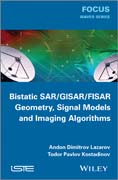
Bistatic SAR / ISAR / FSR
Lazarov, Andon
Kostadinov, Pavlov Todor
Minchev, Petrov Dimitar
Bistatic radar consists of a radar system which comprises a transmitter and receiver which are separated by a distance comparable to the expected target distance. This book provides a general theoretical description of such bistatic technology in the context of synthetic aperture, inverse synthetic aperture and forward scattering radars from the point of view of analytical geometrical and signal formation as well as processing theory. Signal formation and image reconstruction algorithms are developed with the application of high informative linear frequency and phase code modulating techniques, and numerical experiments that confirm theoretical models are carried out. The authors suggest the program implementation of developed algorithms. A theoretical summary of the latest results in the field of bistatic radars is provided, before applying an analytical geometrical description of scenarios of bistatic synthetic aperture, inverse synthetic aperture and forward scattering radars with cooperative and non–cooperative transmitters. Signal models with linear frequency and phase code modulation are developed, and special phase modulations with C/A (coarse acquisition) and P (precision) of GPS satellite transmitters are considered. The authors suggest Matlab implementations of all geometrical models and signal formation and processing algorithms. Contents 1. Bistatic Synthetic Aperture Radar (BSAR) Survey. 2. BSAR Geometry. 3. BSAR Waveforms and Signal Models. 4. BSAR Image Reconstruction Algorithms. 5. Analytical Geometrical Determination of BSAR Resolution. 6. BSAR Experimental Results. 7. BSAR Matlab Implementation. About the Authors Andon Dimitrov Lazarov is Full Professor at Burgas Free University in Bulgaria. His field of interest includes theory, methods and algorithms in the scope of SAR–ISAR–BSAR–InSAR theory, modeling, and signal and image processing. He has authored over 200 research journal and conference papers. He is a member of IEEE, AES Society–USA, TBSR of Applied Electromagnetism–Greece, and guest–editor of a special issue on ISAR signal processing for the IET Journal, Canada. Todor Pavlov Kostadinov is Assistant Professor at Burgas Technical University “Asen Zlatarov” in Bulgaria. His field of interests includes communications, networks and embedded systems, computer science, signal and image processing, image recognition, programming, SAR, ISAR, BSAR and InSAR techniques, methods and algorithms. He is the author of more than 10 journal and conference papers in the field of SAR, ISAR and BSAR technologies. A general theoretical description of bistatic technology within the scope of synthetic aperture, inverse synthetic aperture and forward scattering radars from the point of view of analytical geometrical and signal formation and processing theory. Signal formation and image reconstruction algorithms are developed in this title, with application of high informative linear frequency and phase code modulating techniques. Numerical experiments that confirm theoretical models are carried out and the authors suggest program implementation for the algorithms developed. INDICE: 1. Introduction: Description of recent years’ achievements in the scope of BSAR that includes survey over publications. 2. Chapter one: BSAR/BISAR/FSR Geometry a. BSAR Geometry: Bistatic Synthetic Aperture Radar topology is described from analytical geometrical and kinematical point of view. b. BISAR Geometry: Bistatic Inverse Synthtetic Aperture Radar topology is described from analytical geometrical and kinematical point of view. Main kinematical equations are derived. c. FSR Geometry: Forward Scattering Radar topology is described from analytical geometrical and kinematical point of view. Main kinematical equations are derived. 3. Chapter two: BSAR/BISAR/FSR theoretical constraints and resolution characteristics. 4. Chapter three: BSAR signal modeling and image extractiona. Definition of transmitted signals with linear frequency modulation (LFM); definition of transmitted signal with Barker phase code (BPC) modulation; coarse acquisition (C/A) and precision (P) phase code modulation. b. A model of LFM BSAR signal formation as direct projection operation. c. A model of BPC BSAR signal formation as direct projection operation. d. Image reconstruction from a LFM BSAR signal as inverse projection operation. e. Image reconstruction from a phase code modulated BSAR signal as inverse projection operation f. Autofocusing algorithms 5. Numerical experiments and programming in Matlab environment. a. BSAR scenario: with LFM signal and phase code modulation signal b. BISAR Scenario: with LFM signal and phase code modulation signal. c. FSR Scenario: with LFM signal and phase code modulation signal. 6. Matlab code description 7. Concluding remarks.
- ISBN: 978-1-84821-574-0
- Editorial: ISTE Ltd.
- Encuadernacion: Cartoné
- Fecha Publicación: 29/11/2013
- Nº Volúmenes: 1
- Idioma: Inglés
